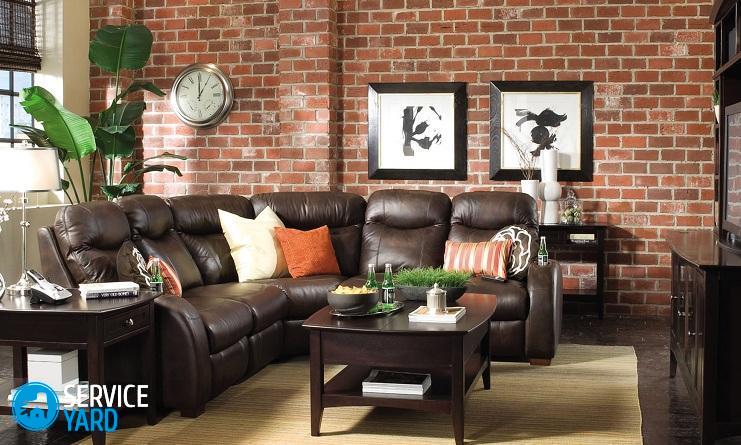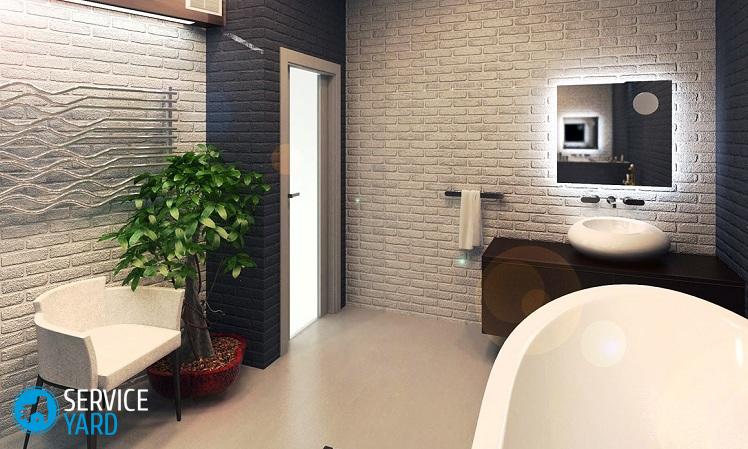Painting a brick wall in the interior

Now becoming more and more popular wall decoration in the room in the form of brickwork. You can experiment with a kitchen apron, fireplace trim, or even with the whole wall. Painting a brick wall in the interior is a great solution for updating the style. But this is not an easy task, because it is necessary to take into account a number of nuances. We will tell you about them in this article so that during the repair you do not have unforeseen situations and problems.
to contents ↑Why paint brick walls?
Modern brick, thanks to modernized technologies, can have a different color, shape, texture and size. But still, in some cases, brickwork needs to be painted. This is done for:
- Protections of the walls. Due to this, the pores of the brick and the joints of the masonry are protected from moisture, which destroys the structure of the material.
- Giving aesthetics. Painting helps to transform the wall, which before that did not fit into the general style of the room.
to contents ↑Important! Painted brickwork is successfully used to design rooms in the style of Hi-tech, Loft, Modern. In addition, the room will look original even if only one wall with brickwork is used.
How to choose a paint?
The surface of the brickwork is porous and rough, in addition, due to the cement joints, it is not uniform. Painting with ordinary paint is quite complicated, so most often they use a special facade. But when acquiring such paint, you should choose the one that is intended for painting masonry. In addition, there is paint, which is separately used for old and new masonry. There are differences in the composition of such paint.
Important! Most specialized paints that are designed for coloring masonry have increased elasticity and the ability to penetrate deeply into the material.
If the masonry is exterior, it is coated with elastomeric paint. It helps protect walls from moisture and temperature changes. But such a paint has a thicker consistency than that of a facade, and it also costs a lot.
To diversify the interior, the choice is much more significant. For painting internal walls, paints are used on different bases. But when choosing, it should be borne in mind that the coating must withstand the alkaline environment, in the case of a bathroom, toilet or kitchen, it must be water repellent.
Alkyd paint
Such an option is an excellent solution, besides, a durable one. The choice of colors is quite large. These paints are based on alkyd resins and acids.
The advantages of the material are that it is firmly bonded to the surface and does not emit toxic or unpleasant odors after drying. But it will be unpleasant that the smell during processing is very strong. Additional disadvantages are represented by the high cost of the material and the high consumption per square meter.
Important! Use solvents to reduce paint consumption.
Acrylic paint
The basis of this paint is acrylic resin. Its distinctive features are a good appearance of the layer, low consumption, a variety of colors and cost. In addition, there is no pungent smell from acrylic products, so they are suitable for residential premises.
Important! The main disadvantage is represented by the not very high strength of the final layer, besides, it is impossible to block small defects on the plane with cheap options.
Given all the pros and cons, you need to know exactly how to paint the wall like a brick, but you can choose acrylic and alkyd paint.
to contents ↑Wall painting
What tools and materials need to be prepared before painting a brick wall in the interior? Their list depends on the state of the wall. Usually preparation is required:
- Wire brush or washcloth;
- Roller silt hard brush;
- Sponges;
- Atomizer;
- Scraper knife;
- Sandpaper;
- Safety glasses;
- Rubber gloves;
- Detergent for walls;
- Paints;
- Cement;
- Grouting;
- Primers.
Important! In order for the tool not to wear out on the surface, it is better to spend money on durable and high-quality products.
Painting work consists of three stages:
- Preparatory.
- Priming.
- Staining.
Training
It depends on the stage how long the paint will last. With proper preparation, all small surface defects represented by small cracks, bumps, and bulges are removed.
Important! If bumps remain on the wall, painting will not be of high quality.
You need to proceed in stages:
- Using a scraper and sandpaper, we get rid of visible defects.
- We clean the prepared surface with a hard brush and detergent. In this case, completely remove the old paint and whitewash.
- Large cracks close up with cement mortar.
- Level the wall using a brush or washcloth.
- The wall dries in ten to twenty days.
Important! The surface must be dry before applying the paint, otherwise - later the wall will be covered with mold and fungus.
Primer
At this stage, a primer is applied so that the paint sticks to the wall better. In addition, the primer gives the wall additional water resistance, prevents the formation of fungus and mold.
The best option would be to use an acrylic primer or latex based primer. Primer the surface two to three times. The product is applied using a roller, and a brush is used for hard to reach places.
Important! First, the first coat of primer is applied, and the second - only after it dries.
Painting
When you decide how to paint the brick wall inside the house, you should start the process itself:
- Usually they use a roller on the rod, due to which stains and smudges do not appear on the wall.
- Painting starts from the top corner. In this case, you should not rush, you will have to apply several layers of paint.
Important! This indicator depends on what the surface characteristics are. If the paint is not very absorbed by the masonry, two layers will be sufficient, and when using porous brick, at least three layers will be required.
- The first layer is applied with a little diluted paint, and when it dries, you can apply the next. After you need to let the paint dry well.
Stock footage
Painting a brick wall is not very difficult. It is much more difficult to choose a coloring composition and prepare the surface. In this case, you should listen to the recommendations of specialists.
- How to choose a vacuum cleaner taking into account the characteristics of the house and coatings?
- What to look for when choosing a water delivery
- How to quickly create comfort at home - tips for housewives
- How to choose the perfect TV - useful tips
- What to look for when choosing blinds
- What should be running shoes?
- What useful things can you buy in a hardware store
- Iphone 11 pro max review
- Than iPhone is better than Android smartphones





